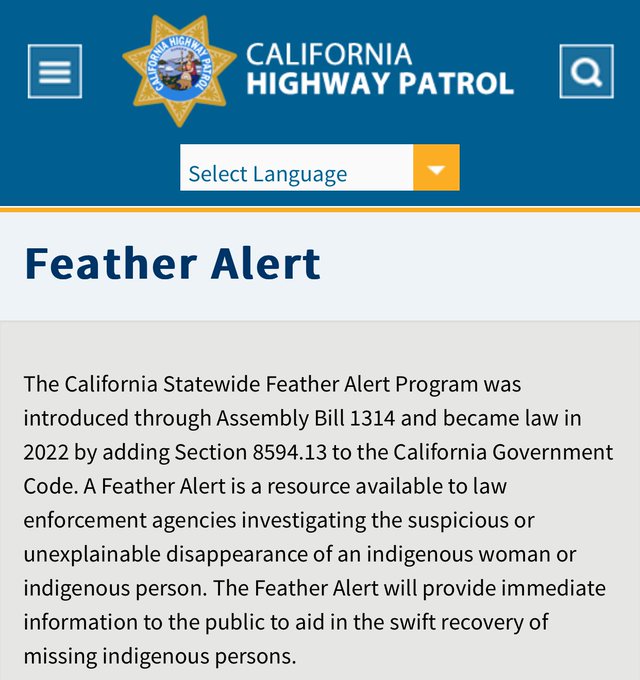Cali's 'Ebony Alerts' Are Unconstitutional (and You Won't Believe What They Have For Native Americans)
http://twitchy.com/aaronwalker/2024/02/18/ebony-alerts-violate-the-fourteenth-amendment-n2393046
Early on Friday Morning, the California Highway Patrol issued this Ebony Alert:

Oh ... I don't think that was the one they recently issued. Hold on a minute ... let's see if we can find the correct one. Ah ... here it is ...
CHP - Alerts (@CHPAlerts) ~ EBONY ALERT - Los Angeles County
Last seen: West 102nd Street and Figueroa Street, Los Angeles
@LAPDHQ

As of this writing there are over 34 million views and thatâs probably good. But at least some of the views were probably generated by the shock that there is such a thing as an Ebony Alert. And an Ebony Alert is what you might guess: Something like an Amber Alert that is only issued when the missing youth is black.
Yeah, 'cuz an "Amber Alert" is for missing yutes with amber complexions, right???

But first, letâs talk about what the Constitution says. This is one of those situations where the ordinary meaning of a word is different from how it is understood in the law. In ordinary parlance, âdiscriminationâ means to treat people differently according to an unjust factor such as race. But in constitutional law, 'discrimination' means literally to classify â even if the government does nothing with that classification. If the government just keeps a list of who is black, white or whatever, but still treats everyone otherwise equally, that is racial discrimination.
Furthermore, in constitutional law, not all discrimination is illegal or wrong. After all, the government discriminates, classifies people and things all the time. To give one example, a regulatory scheme might rightfully treat bus drivers differently than airline pilots â setting up different standards for health, eyesight and proficiency, for instance. Or in a more basic way, two people might both be tried for murder and one person might go free, while the other is convicted and punished. Even if that is based on nothing more than the evidence, that is still discrimination, still classification, between a person proven guilty, versus a person who is not.
What the Supreme Court has said is the discrimination is considered more or less suspicious, depending on what factors are being considered. Discrimination against disabled people is not considered very suspicious at all, to pick one example. Discrimination against women or illegitimate status is more suspicious. And the most suspicious of all is discrimination based on race. Therefore, any discrimination, any classification, based on race has to be narrowly tailored to serve a compelling interest. It is exceedingly rare for any kind of discrimination to pass that test.
Thus we come back to this idea of Ebony Alerts. This concept is actually written into California state law. Specifically, it's in Cal. Gov. Code § 8594.14. Thereâs a lot there but here are the criteria:
(c) A law enforcement agency may request that an Ebony Alert be activated if that agency determines that an Ebony Alert would be an effective tool in the investigation of missing Black youth, including a young woman or girl. The law enforcement agency may consider the following factors to make that determination:
(1) The missing person is between 12 to 25 years of age, inclusive.
(2) The missing person suffers from a mental or physical disability.
(3) The person is missing under circumstances that indicate any of the following:
(A) The missing personâs physical safety may be endangered.
(B) The missing person may be subject to trafficking.
(4) The law enforcement agency determines that the person has gone missing under unexplained or suspicious circumstances.
(5) The law enforcement agency believes that the person is in danger because of age, health, mental or physical disability, or environment or weather conditions, that the person is in the company of a potentially dangerous person, or that there are other factors indicating that the person may be in peril.
(6) The investigating law enforcement agency has utilized available local resources.
(7) There is information available that, if disseminated to the public, could assist in the safe recovery of the missing person.
One thing to understand when you read the law is the code words often used by the legislature. For instance, if a law says someone shall do something, that is almost always interpreted as saying that the person has no choice in the matter. But the word âmayâ is almost always permissive. You may do it, but you donât have to.
So, bluntly, no law enforcement agency has to do any of this, and we think they should refuse to do it because it violates the Equal Protection Clause of the Fourteenth Amendment. There is nothing in the Amber Alert system that excludes black people, even if they also qualify for Ebony Alerts, so they should stick to the Amber Alert system.
But more insidiously, all those factors mentioned in the Ebony Alert laws like disability status, age and so on are optional, too (âThe law enforcement agency may consider the following factorsâ). The only criteria that must be present is 1) that the law enforcement agency determines that would be an effective tool the in the investigation and 2) that the person be a black youthâwhatever that means.
Further, as the title to this article promised, they donât just have an Ebony Alert for young black people who are missing. Nope, they also have one for Native Americans in Cal. Gov. Code § 8594.13. And it uses a heck of a term: Feather Alert.
No, we are not making this up. We wish we were, but we arenât.
Los Angeles Times (@latimes) ~ Tribal leaders cite problems with California's Feather Alert for Native people who go missing

http://www.latimes.com/california/story/2024-01-29/california-feather-alert-tribal-leaders-warn-problems
Of course, there are other types of alerts. For instance, California also provides for:
* âAmber Alertsâ involving missing children under the age of 18, Cal. Gov. Code § 8594âwe will assume you have heard of Amber Alerts by now;
* âBlue alertsâ involving attacks on police officers where the suspect has fled, Cal. Gov. Code § 8594.5;
* âSilver Alertsâ involving missing elderly or disabled persons, Cal. Gov. Code § 8594.10; and
* âMissing person advisoryâ which applies to anyone âat riskâ or disabled, Cal. Gov. Code § 8594.11.
Also, when we saw they had something called a âYellow Alert,â we braced ourselves, thinking that this might be for Asian-Americans or something like that. But, in fact, it refers to hit-and-run situations where a person has died. Cal. Gov. Code § 8594.15.
But that brings us to the most indefensible part of this statutory scheme. This guy gets at it in a different way:
Mario Presents Official (@Mario_Presents) ~ Amber alert (missing child) gave way to Ebony alert (missing BLACK person).
Indigenous now have their own notification... Feather alert.
When will California add Curry, Rice, and Sombrero alert to the list?

Yes, as of now, there is a special alert for missing black people and missing Native Americans ⦠and no other race. So missing Latino, Asian and white children will be treated separately from Black and Native American children.
Well, no doubt that Kalifornia is ready, willing, and able to seal this breach, as it were, with appropriately named ALERTS for these other races ...
* Curry Alert for Indian and Pakistani kids (as previously mentioned above)
* Slant Eyed Alert for Asian kids
* Taco or Enchilada Alert for Hispanic kids
* Honky or Cracker Alert for White kids
No?!
After all, this all started with Amber Alerts, which are named after Amber Rene Hagerman who was abducted and murdered when she was 9, in California. The point of these alerts are obvious: To get special attention in the community, because we want to work extra hard to protect children.
Oh ... "Amber Alerts" are named for Amber Hagerman, not kids with amber complexions, eh? I am SOOOOOOOOOOOOOOOO embarrassed!

So, if we are supposed to pay extra attention when it is an Amber Alert, what are we supposed to do with an Ebony Alert or a (sigh) Feather Alert? We doubt it is because the government is sending the message that we have to treat this disappearance as being no different from any other.
Mind you, we are not saying that race is completely irrelevant in handling missing persons reports, whether they are Amber Alerts, Silver Alerts or something else. After all, these alerts are also accompanied with a general description which includes race, sex and age. We think a simple notation of the personâs race would pass muster under the constitutional test for racial discrimination because it is narrowly tailored to serve a compelling purpose: Describing race as part of providing a general description to help people actually recognize the person more easily. One major problem we have with these Ebony and Feather Alerts is with segregating these alerts by race, putting the race of the individual front and center as if it is the most important thing to pay attention to when it is not. An Asian mother cries just as much when she misses her daughter as a black mother.
In fact, the criteria used for Ebony and Feather Alerts are different from ordinary Amber Alerts. We said in the beginning that an Ebony Alert is âsomething like an Amber Alert that is only issued when the missing youth is black.â Well, it is something like it, but not quite identical, and many of the differences between an Amber Alert and an Ebony or Feather Alert mean that a black or Native American youth will get an alert when children of other races wonât.
For instance, in California, Amber Alerts require proof of abduction, that the child be 17 years old or younger, or have a âprovenâ disability.
By comparison, we just saw that Ebony Alerts can be issued for children 12-25 years old (and theoretically older or younger), or if the black youth has a disability (no mention of it being a âprovenâ one like with Amber Alerts). Abduction doesnât have to be determined, the person only has to go missing under âsuspiciousâ or âunexplained circumstances,â if law enforcement believes they are endangered or may be subject to trafficking. Feather alerts have similarly relaxed criteria.
So, imagine this scenario. An Asian man and his black wife both live in California. Like the Brady Bunch, they both brought children into the marriage. One is Joe, son of the black wife and he is himself black. The other is Jane, daughter of the Asian husband and she is herself Asian. Both Joe and Jane are 13 years old and loved dearly by both parents. Each parent loves their step children as much as Uncle Ben and Aunt May loved Peter Parker.
And imagine both children go missing. No one knows how or why they are missing but the circumstances of their disappearance are suspicious. Under this law, California authorities would have the power to issue an Ebony Alert for the black son, but because abduction is not proven, they canât even issue an Amber Alert for the Asian daughter. She gets no alert. That in turn creates the very real possibility that one child might die (or face other horrors) and the other might be saved, because of the race that child happens to be.
The same could be said if you modified the circumstances, slightly. Suppose both children were adults, aged 21. Suppose further that the parents had absolute video proof that Jane and Joe were simultaneously abductedâperhaps they have footage from their home security camera, recorded when the parents were at work. Well, Amber Alerts only apply to children below the age of 18, while an Ebony Alert can at least go to the age of 25. So again, Joeâs abduction earns an Ebony Alert while Jane doesnât merit any alert at all. Again, these parents might see their son saved but not their daughter because the official policy of the state of California is that Asian lives donât matter as much as black ones.
It is hard to imagine a more heartless form of discrimination.
And not for nothing, but the Fourteenth Amendment doesnât literally say âdonât discriminate against people.â That is a reasonable summary of what it means, but what it actually says is ...
No State shall ⦠deny to any person within its jurisdiction the equal protection of the laws.
No State shall ⦠deny to any person within its jurisdiction the equal protection of the laws.
So the actual language says that the state is supposed to protect people equally. Can you tell the mother of a missing Asian, Latino or white child living in California that her children are being equally protected? Of course not.
Even the language on the California Highway Patrol website is discriminatory. One danger of putting out a separate alert by race is that people of other races might not care because of it. An anti-Native racist might read every Amber Alert, but ignore Feather Alerts because he knows up front that this involves Native Americans.
And while we assume this is unintentional, the language of the California Highway Patrol website indicates you should care less about Ebony Alerts, too. After all it, says this about Amber Alerts: âAMBER Alerts are the most serious alerts we can issue involving children.â There is no similar wording when they talk about Ebony Alerts, so the implication is that it is less serious when black youth are missing.
And so far, weâve ignored another question: What makes a person black or Native American in the first place? Is Barack Obama black? In fact, he only has one black parent. Just how black do you have to be to qualify? Or Native American? Elizabeth Warren claims to be 1/1032nd Cherokee (donât laugh), so would she have been Native American enough to qualify when she was younger? Would Shawn King qualify as black? What about Rachel Dolezal?
Do you start to see how racist these things start to get when you treat people differently by race?
Of course, in the South, we used to have laws that laid out careful criteria for racial identity. They were called The Black Codesâand they were passed by Democrats, too! Of course we were being very sarcastic right there, but we keep hearing that there has been some kind of great party switch between those days and 2024, but Democrats donât seem to have changed very much.

Angel Eduardo (@StrangelEdweird) ~ I would be thrilled to discover that there isnât a separate alert for kids based on their raceâebony for âblackâ kids, feather for native kidsâbecause there is nothing about a kidâs skin color or race that should change anything about how we respond to their going missing.
Finally, some sanity.
Seriously, amen to that.

The essential American soul is hard, isolate, stoic, and a killer. It has never yet melted. ~ D.H. Lawrence
